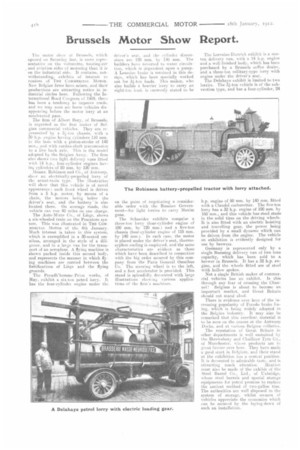Brussels Motor Show Report.
Page 18

If you've noticed an error in this article please click here to report it so we can fix it.
The motor show at Brassiele, which opened on Saturday last, is more representative on the voiturette, touring-car and aviation sides of motoring than it is on the industrial side. It contains, notwithstanding, exhibits of interest to readers of THE COM M ER.CIA 1. Al OTOR. New Belgian firms have arisen. and theix productions are attracting notice in industrial circles here. Following the International Road Congress of 1909, there has been a tendency to improve roads. and we may soon see horse vehicles disappearing before the motor lorry at an accelerated pace. The firm of Albert Bory, of Brussels, is regarded as the first maker of Belgian commercial vehicles. They are represented by a 3;4mi chassis, with a 30 h.p. engine having cylinders 110 mm. in the bore with a piston-stroke of 140 nee., and with eardarashaft transmission to a live back axle. This is the model adepted by the Belgian Array. The firm also shows two light delivery vans fitted with 14 lap., four-cylinder engines hayine. cylinders of 80 rum. by 120 mm.
Messrs. Robinson and Co., of Antwerp, show an electrically-propelled lorry of the avant-train type. The illustration will show that this vehicle is of novel appearance ; each front wheel is driven from a 5 tr.p, motor, by means of a chain, the motors being below the driver's seat, and the battery 'is also located there. On average roads, the vehicle can run 40 miles on one charge.
The Auto-Mixte Co., of Liege, shows a six-wheeled train on the Pescatore syetem. This was illustrated in THE COMMERCIAL MOTOR Of the 4th January. Much interest is taken in this system, which is exemplified in a. 30-seated omnibus, arranged in the style of a diligence, and in a large van for the transport of an aeroplane. A flying machine is shown packed inside this second body, and represents the manner in which flying machines are carried between the fortifications of Liege and the flying grounds. The Preudh'humme-Piion works, of Huy, exhibit a six-ten petrol lorry. It has the four-cylinder engine under the driver'e seat, and the cylinder dimensions are 120 mm. by 140 mm. The builders have reverted to water circulation, which is dependent upon a pump. A Lemoine brake is retained in this design, which has been specially worked out for 3i.ton loads. This maker, who also builds a heavier lorry to carry an eight-ton lead, is currently stated to be an the point of negotiating a considerable order with the Russian Government—for light lorries to carry Maxim guns. The Schneider exhibits comprise a three-ton lorry (four-cylinder engine of 100 mm. by 120 mm.) and a five-ten chassis (four-cyliuder engine of 125 mm. by 140 mm.). In each ease, the motor is placed under the driver's seat, thermosyphon cooling is employed, and the same characteristics are evident as those which have been described in connection with the big order secured by this company from the Paris General Omnibus Co. The steering wheel is to the left, and a foot accelerator is provided. This stand is splendidly decorated with large illustrations showing various applications of the firm's meanies.
The Lorraine-Dietrich exhibit is a oneton delivery van, with a 14 lap. engine and a well-finished body, which has been purchased by a Brussels coffee dealer, and a three-ton military-type lorry with engine under the driver's seat. The Delahaye exhibit is limited to two lorries. The 30on vehicle is of the subvention type, and has a four-cylinder, 24
h.p. engine of 80 mm. by 140 mm. fitted with a Claudel carburetter. The five-ton lorry has a 32 h.p. engine of 100 mm. by 160 mm., and this vehicle has steel studs in the solid tires on the driving wheels. It is also fitted with an electric hoisting and travelling gear, the power being provided by a small dynamo which can he driven from the engine. The vehicle on exhibition is evidently designed for use by brewers. Germany is represented only by a single Buessing delivery van of two tons capacity, which has been sold to a brewer in Brussels. It has a 32 h.p. engine, and the wheels fitted are of steel with hollow spokes. Not a single British maker of commercial vehicles has an exhibit. Is this through any fear of crossing the Channel'? Belgium is about to become an important market. and Great Britain should not stand aloof.
There is evidence over here of the increasing popularity of Ferodo brake lining, which is being widely adopted in the Belgian industry. It may also be remarked that this excellent, material is to be seen on the cranes at the Antwerp Docks, and at various Belgian collieries. The reputation of Great Britain in other departments is well sustained by the Shrewsbury and Challiner Tyre Co., ef Manchester', whose products are in great favour neer here. They have made a good start in Belgium, and their stand at the exhibition has a central position. It is decorated in admirable taste, and is attracting much attention. Mention must also he made of the exhibit of the Steel Barrel Co., Ltd., of Uxbridge, whose steel barrels arid special storage equipments for petrol promise to replace the ancient method of two-gallon tins. The authorities are well disposed to the system of storage, whilst owners of vehicles appreciate the economies which can be secured by the laying-down of such an installation.






















